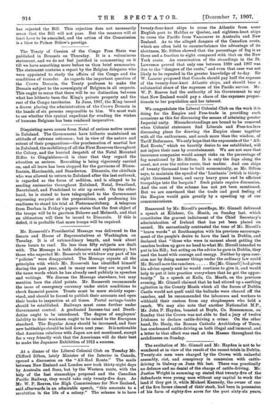At a dinner of the Liberal Colonial Club on Tuesday
Mr. Clifford Sifton, lately Minister of the Interior in Canada, opened a discussion on the "All-Red Route." The mails between New Zealand and London now took thirty-eight days by Australia and Suez, but by the Western route, with the help of the fast steamships proposed and the Canadian Pacific Railway, they would take only twenty-five days. As Mr. W. P. Reeves, the High Commissioner for New Zealand, said afterwards in an admirable speech, " this amounts to a revolution lb the life of a colony." The scheme is to have
twenty-four-knot ships to cross the Atlantic from some English port to Halifax or Quebec, and eighteen-knot ships to cross the Pacific from Vancouver to Australia and New Zealand. As to the alleged dangers of the Canadian route, which are often held to counterbalance the advantage of its shortness, Mr. Sifton showed that the percentage of fog is as three and a fraction to eight compared with that on the New York route. An examination of the strandings in the St. Lawrence proved that only one between 1880 and 1907 was due to the "dangers of the route," and even that case was not likely to be repeated in the greater knowledge of to-day. Sir W. Laurier proposed that Canada should pay half the expense of the twenty-four-knot Atlantic ships, and should bear a substantial share of the expenses of the Pacific service. Mr. W. P. Reeves had the authority of his Government to say that New Zealand would pay a share of the expenses propor- tionate to her population and her interest.










































































 Previous page
Previous page